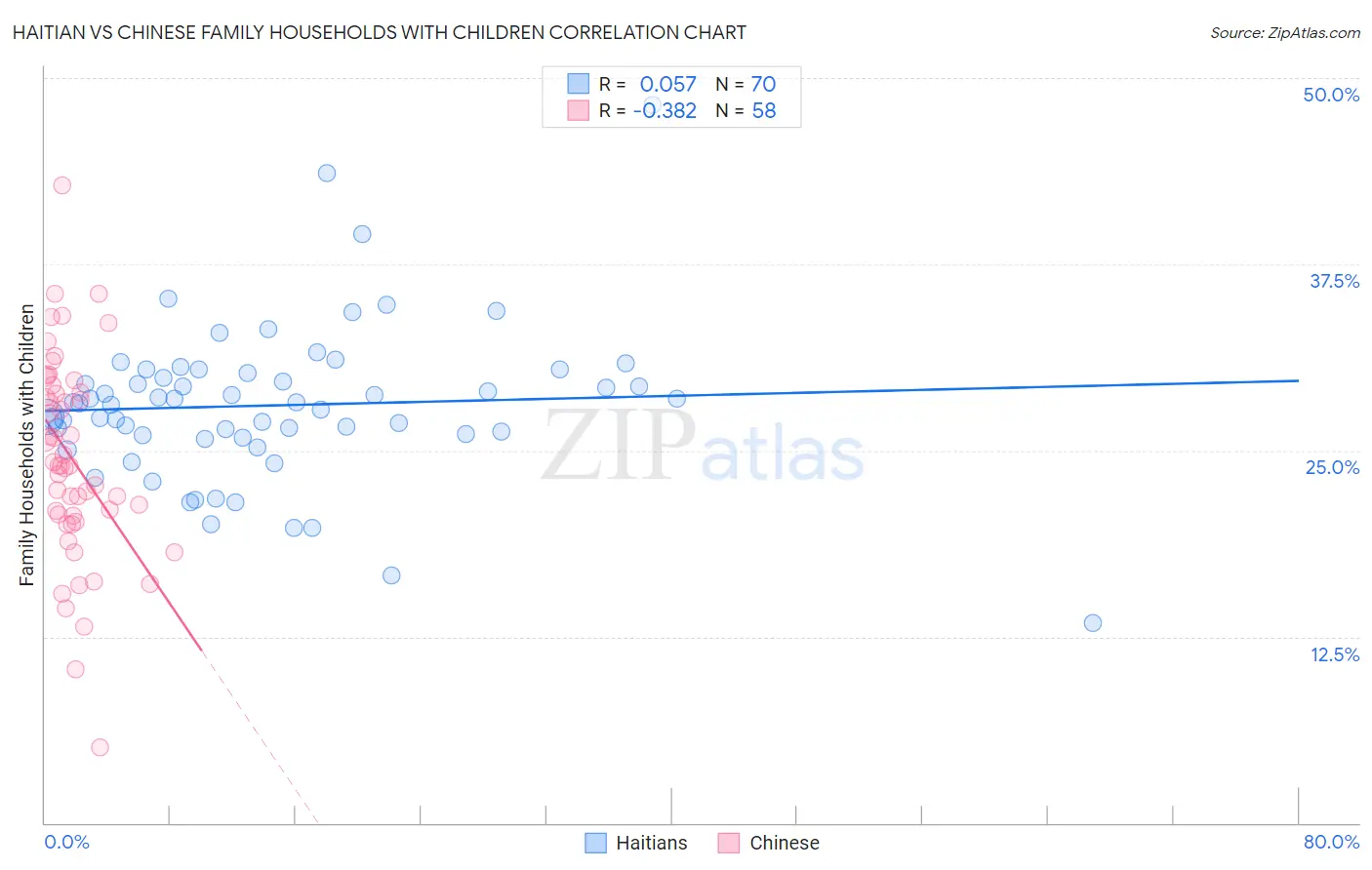Haitian vs Chinese Family Households with Children
COMPARE
Haitian
Chinese
Family Households with Children
Family Households with Children Comparison
Haitians
Chinese
27.2%
FAMILY HOUSEHOLDS WITH CHILDREN
19.8/ 100
METRIC RATING
207th/ 347
METRIC RANK
26.0%
FAMILY HOUSEHOLDS WITH CHILDREN
0.0/ 100
METRIC RATING
324th/ 347
METRIC RANK
Haitian vs Chinese Family Households with Children Correlation Chart
The statistical analysis conducted on geographies consisting of 287,598,157 people shows a slight positive correlation between the proportion of Haitians and percentage of family households with children in the United States with a correlation coefficient (R) of 0.057 and weighted average of 27.2%. Similarly, the statistical analysis conducted on geographies consisting of 64,800,060 people shows a mild negative correlation between the proportion of Chinese and percentage of family households with children in the United States with a correlation coefficient (R) of -0.382 and weighted average of 26.0%, a difference of 4.7%.

Family Households with Children Correlation Summary
| Measurement | Haitian | Chinese |
| Minimum | 13.4% | 5.1% |
| Maximum | 48.2% | 42.8% |
| Range | 34.8% | 37.7% |
| Mean | 28.0% | 24.4% |
| Median | 28.2% | 24.0% |
| Interquartile 25% (IQ1) | 26.0% | 20.6% |
| Interquartile 75% (IQ3) | 30.2% | 28.8% |
| Interquartile Range (IQR) | 4.2% | 8.2% |
| Standard Deviation (Sample) | 5.3% | 6.8% |
| Standard Deviation (Population) | 5.3% | 6.7% |
Similar Demographics by Family Households with Children
Demographics Similar to Haitians by Family Households with Children
In terms of family households with children, the demographic groups most similar to Haitians are Immigrants from Micronesia (27.2%, a difference of 0.010%), Immigrants from Haiti (27.2%, a difference of 0.020%), Immigrants from Sudan (27.3%, a difference of 0.060%), Kiowa (27.3%, a difference of 0.080%), and American (27.3%, a difference of 0.10%).
| Demographics | Rating | Rank | Family Households with Children |
| Immigrants | Congo | 28.7 /100 | #200 | Fair 27.3% |
| Bhutanese | 25.1 /100 | #201 | Fair 27.3% |
| Americans | 22.8 /100 | #202 | Fair 27.3% |
| Kiowa | 22.2 /100 | #203 | Fair 27.3% |
| Immigrants | Sudan | 21.6 /100 | #204 | Fair 27.3% |
| Immigrants | Haiti | 20.3 /100 | #205 | Fair 27.2% |
| Immigrants | Micronesia | 20.2 /100 | #206 | Fair 27.2% |
| Haitians | 19.8 /100 | #207 | Poor 27.2% |
| Immigrants | Poland | 16.4 /100 | #208 | Poor 27.2% |
| Dutch West Indians | 15.8 /100 | #209 | Poor 27.2% |
| Immigrants | Ukraine | 14.4 /100 | #210 | Poor 27.2% |
| Welsh | 14.2 /100 | #211 | Poor 27.2% |
| Immigrants | Dominica | 13.9 /100 | #212 | Poor 27.2% |
| Okinawans | 13.7 /100 | #213 | Poor 27.2% |
| Africans | 13.0 /100 | #214 | Poor 27.2% |
Demographics Similar to Chinese by Family Households with Children
In terms of family households with children, the demographic groups most similar to Chinese are Immigrants from Australia (26.0%, a difference of 0.030%), Barbadian (26.0%, a difference of 0.060%), Immigrants from Greece (26.0%, a difference of 0.070%), British West Indian (26.0%, a difference of 0.080%), and Immigrants from Ireland (26.0%, a difference of 0.080%).
| Demographics | Rating | Rank | Family Households with Children |
| Ottawa | 0.0 /100 | #317 | Tragic 26.1% |
| Iroquois | 0.0 /100 | #318 | Tragic 26.1% |
| Immigrants | France | 0.0 /100 | #319 | Tragic 26.0% |
| Tlingit-Haida | 0.0 /100 | #320 | Tragic 26.0% |
| British West Indians | 0.0 /100 | #321 | Tragic 26.0% |
| Immigrants | Greece | 0.0 /100 | #322 | Tragic 26.0% |
| Immigrants | Australia | 0.0 /100 | #323 | Tragic 26.0% |
| Chinese | 0.0 /100 | #324 | Tragic 26.0% |
| Barbadians | 0.0 /100 | #325 | Tragic 26.0% |
| Immigrants | Ireland | 0.0 /100 | #326 | Tragic 26.0% |
| Immigrants | Barbados | 0.0 /100 | #327 | Tragic 26.0% |
| Immigrants | Albania | 0.0 /100 | #328 | Tragic 25.9% |
| Cypriots | 0.0 /100 | #329 | Tragic 25.9% |
| Immigrants | Latvia | 0.0 /100 | #330 | Tragic 25.9% |
| Slovenes | 0.0 /100 | #331 | Tragic 25.8% |